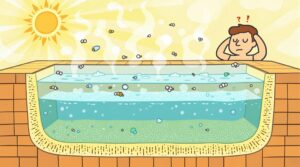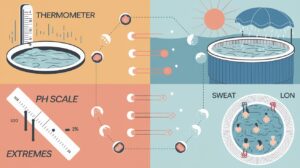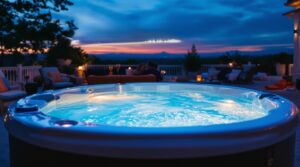Why Does the Chlorine in My Hot Tub Disappear? A Comprehensive Guide
Welcome to your in-depth guide on a common hot tub mystery: the vanishing chlorine. If you have ever wondered why your chlorine levels drop fast, you are not alone. Chlorine is added to hot tubs to keep the water clean and free of germs. But over time, many factors make the chlorine “disappear” from your hot tub. In this post, we break down the science and practical tips behind this issue. You will learn about the role of chlorine, the effects of temperature, sunlight, and pH, and much more. We even include charts, tables, and a glossary of key terms to help you understand every detail.
In simple terms, chlorine is like a helper that works hard to keep your water safe. When you use your hot tub, your body oils, sweat, and lotions mix with the water. Chlorine then reacts with these substances and is used up in the process. High water temperatures speed up these reactions, while sunlight can break down chlorine. The pH of the water also plays a big part. When the pH is not in the right range, chlorine does not work as well. This guide explains all these factors in plain language and gives you easy steps to solve the mystery of disappearing chlorine.

In this blog post, you will learn:
- How chlorine works and why it gets used up.
- The impact of temperature, sunlight, and water chemistry.
- How to compare different cleaning methods.
- Steps to maintain proper chlorine levels.
- Tips for troubleshooting common problems.
- Innovative ways to keep your water clean over time.
Let’s dive in and explore every part of the problem so you can keep your hot tub sparkling and safe. The next sections will guide you step by step through the science, the best practices, and the smart tools you can use.
Understanding How Chlorine Works in Your Hot Tub
Chlorine is not lost; it is used up. It reacts with contaminants like sweat and oils. When this happens, chlorine is transformed into compounds that do not kill germs. Here are the main points:
-
Sanitization and Oxidation:
Chlorine kills bacteria and oxidizes dirt. This process uses up the chlorine in your hot tub. -
UV Degradation:
Sunlight breaks down chlorine molecules. Outdoor hot tubs lose chlorine faster when exposed to the sun. -
High Temperature Effects:
Hot water speeds up chemical reactions. At temperatures around 100°F, chlorine is consumed quickly. -
pH Imbalance:
Chlorine works best when the pH is between 7.2 and 7.8. If the pH is too high or too low, chlorine loses strength. -
Chloramines Formation:
When chlorine meets organic matter, it forms chloramines. These are less effective at cleaning water.
“Good water chemistry is the heart of a clean hot tub.”
– Hot Tub Maintenance Expert
Below is a simple table that compares the major reasons for chlorine loss:
| Factor | Effect on Chlorine | Simple Solution |
|---|---|---|
| High Temperature | Speeds up chlorine use | Test frequently; lower temperature if possible |
| Sunlight Exposure | Breaks down chlorine (UV damage) | Use a cover; add stabilizer cautiously |
| pH Imbalance | Reduces chlorine effectiveness | Adjust pH to 7.2–7.8 |
| Organic Contaminants | Consumes chlorine by forming chloramines | Shower before use; shock the tub |
Chlorine works hard in your hot tub. It is like fuel in a car: once burned, it is gone. The more impurities there are, the faster the chlorine is used up. Next, we look at how you can compare different methods to keep chlorine working longer.

Comparative Analysis: Managing Chlorine Levels
When you compare ways to maintain chlorine levels, you must look at cost, ease of use, and how well each method works. The table below shows a side-by-side view of some common options.
| Method | Cost | Effectiveness | Ease of Use | Best For |
|---|---|---|---|---|
| Regular Chlorine Dosing | Low | Good if done right | Easy | Everyday use |
| Shock Treatments | Medium | Very effective for contaminants | Moderate | After heavy use |
| Bromine | Medium | Stable at high temps | Easy | High temperature tubs |
| Stabilized Chlorine | Low-Medium | Good UV protection | Easy | Outdoor tubs (with caution) |
Each method has pros and cons. For example, regular chlorine dosing is cost-effective, but if many people use the tub, you might need to shock it more often. Bromine is more stable at high temperatures but can be slightly more expensive.
Quick Recommendation:
- For small family use: Regular dosing and weekly shocking work well.
- For heavy use or outdoor tubs: Consider using bromine or stabilized chlorine with proper testing.
A simple HTML diagram below shows the flow of how chlorine is consumed:
This diagram helps you visualize the steps where chlorine is lost. Knowing each step can help you make better choices for maintenance.
Performance Factors That Affect Chlorine Efficiency
Several factors work together to affect chlorine levels. Here are the key points ranked by importance:
-
Organic Contaminants:
The more organic matter (sweat, oils, etc.) you add, the faster chlorine is used up. -
Water Temperature:
Hot water speeds up all chemical reactions, including chlorine breakdown. -
Sunlight (UV Exposure):
Sunlight breaks down chlorine, especially if your hot tub is outdoors. -
pH and Alkalinity:
When the pH is not in the ideal range, chlorine does not work well. -
Stabilizer Levels:
Too much cyanuric acid can bind with chlorine and reduce its effectiveness.
Visual Representation of Factor Interaction
Below is a simple HTML chart that shows how these factors interact:
Each arrow shows how one factor leads to the next. This chart is a simple guide to understanding the process.
Implementation Guide: Steps to Maintain Proper Chlorine Levels
Follow these steps to keep your chlorine levels steady and your water safe:
-
Test Your Water Regularly:
- Use test strips or a digital kit.
- Check for chlorine, pH, and alkalinity at least twice a week.
- Adjust chemicals as needed.
-
Adjust Water Temperature:
- Keep your hot tub around 100°F if possible.
- Lower the temperature if chlorine seems to drop too fast.
-
Manage pH and Alkalinity:
- Use pH increaser or decreaser to keep levels between 7.2 and 7.8.
- Maintain total alkalinity in the range of 80–120 ppm.
-
Shock the Hot Tub:
- Shock the tub weekly or after heavy use.
- Use a chlorine shock or a non-chlorine oxidizer (MPS).
- Follow instructions carefully and let the water rest after shocking.
-
Cover Your Hot Tub:
- Always use the cover when the tub is not in use.
- A cover reduces sunlight exposure and keeps debris out.
-
Encourage Good Bather Hygiene:
- Ask users to shower before using the tub.
- This step reduces the amount of oils and sweat that enter the water.
-
Clean the Filters and Surfaces:
- Clean filters every 1-2 weeks.
- Wipe down the waterline and surfaces to remove biofilm.
-
Monitor Stabilizer Levels (if applicable):
- If using stabilized chlorine, keep cyanuric acid levels below 50 ppm.
- Too much stabilizer can cause chlorine lock.
-
Check Equipment:
- Ensure that your pump and jets work well.
- Good circulation helps mix the chemicals evenly.
Warning: Failing to balance pH or letting filters clog can lead to rapid chlorine loss. Always follow safety guidelines when handling chemicals.
By following these steps, you will have a strong plan to maintain your chlorine levels. With regular testing and proper care, you can keep your hot tub water clean and inviting.

Troubleshooting Common Chlorine Issues
When you find that chlorine levels drop quickly, try these troubleshooting tips:
-
Problem: Low Chlorine After Heavy Use
- Diagnosis: High bather load means more contaminants.
- Solution: Shock the hot tub after heavy use and add a small dose of chlorine.
-
Problem: Cloudy Water and Chlorine Odor
- Diagnosis: Likely chloramines are forming due to organic matter.
- Solution: Perform a shock treatment to break down chloramines.
-
Problem: Inaccurate Test Readings
- Diagnosis: Old or faulty test strips can give false results.
- Solution: Replace your test strips or use a digital tester and follow the instructions carefully.
-
Problem: Rapid Chlorine Loss in Sunlight
- Diagnosis: UV rays are breaking down chlorine quickly.
- Solution: Use a hot tub cover and, if needed, a small dose of stabilizer (with caution).
-
Problem: pH Out of Range
- Diagnosis: Incorrect pH makes chlorine less effective.
- Solution: Adjust the pH using a pH increaser or decreaser.
Below is a simplified flow diagram in text form to help you decide what to do:
- Step 1: Test water → Is chlorine low?
- Yes: Check pH and alkalinity.
- No: Continue regular maintenance.
- Step 2: If pH is off, adjust pH → Test again.
- Step 3: If chlorine remains low, shock the tub.
- Step 4: Re-test and adjust chlorine dosing.
“Regular testing and quick action can save you time and money.”
– Spa Maintenance Professional
This troubleshooting guide helps you solve problems in order of ease and effectiveness. Remember, prevention through regular testing is key.
Innovation and Extended Applications
Hot tub maintenance is always evolving. Here are some fresh ideas and trends:
-
Alternative Sanitizers:
Many users now try bromine. Bromine is more stable in hot water and less sensitive to pH changes. Some even use mineral sanitizers with silver or copper ions to reduce chlorine use. -
Ozone and UV Systems:
These systems can work alongside chlorine. Ozone generators and UV light can kill germs without relying solely on chemicals. They reduce the load on chlorine and help keep the water clear. -
Smart Technology:
There are now apps and smart sensors that monitor water chemistry in real time. They can send alerts to your phone when chemical levels are off, making maintenance easier. -
Eco-Friendly Approaches:
Some hot tub owners choose to use fewer chemicals and rely on natural filtration methods. While this requires extra care and testing, it is a growing trend for those who want a greener solution. -
Improved Equipment:
Newer hot tub models offer better circulation and more efficient heating systems. These improvements help maintain balanced water chemistry and reduce the demand on chlorine.
By staying up to date with new technologies, you can choose methods that save time and reduce chemical use. This section shows that innovation is not just for big businesses—it can make your hot tub experience even better.
Long-term Considerations for Hot Tub Chlorine Management
Looking after your hot tub is a long-term project. Here are some points to keep in mind:
-
Sustainability:
Regular water changes and proper chemical balancing ensure that your hot tub lasts longer. Reducing chemical use can also be better for the environment. -
Maintenance Requirements:
A well-kept hot tub needs regular cleaning, testing, and occasional draining. A good schedule prevents buildup and saves money over time. -
Longevity Estimates:
With proper care, your hot tub can remain safe and effective for years. Watch for signs like persistent cloudy water or bad odors as hints that maintenance is overdue. -
Upgrade Indicators:
If you find that you need to add more chemicals than usual, or if your equipment is aging, it might be time to upgrade or even replace parts of your system. -
Cost-Benefit Analysis:
Spending a little extra time on maintenance now can save you from expensive repairs later. Regular testing and proper dosing help you avoid larger problems.
Expert FAQ
Q1: Why does my chlorine level drop right after I use the hot tub?
A: Heavy use introduces more contaminants. Chlorine works to break these down, so it is used up quickly.
Q2: How often should I test my hot tub water?
A: Test at least 2-3 times per week, and more after heavy use or after a rainstorm.
Q3: Can I use a pool chlorine product in my hot tub?
A: No. Use chlorine products made for hot tubs. They are designed to work in warm, smaller water volumes.
Q4: Is bromine better than chlorine for hot tubs?
A: Bromine is more stable at high temperatures and works well with hot tubs. However, it can be more expensive.
Q5: What is the best way to protect chlorine from the sun?
A: Always cover your hot tub when not in use. A cover reduces UV exposure and helps keep chlorine levels stable.
Q6: How do I know if I have a pH imbalance?
A: Use test strips to check your pH. It should be between 7.2 and 7.8. If it is not, adjust it with the proper chemicals.
Q7: How much does maintaining chlorine levels cost?
A: Costs vary by usage and product choice. Regular maintenance saves money by preventing costly repairs later.
Conclusion
In this guide, we have explored why chlorine in your hot tub seems to vanish. We learned that chlorine is not lost by magic—it is used up by reacting with organic matter, UV light, heat, and pH imbalances. You now know that proper testing, regular shocking, and careful water balance are key to maintaining safe water. By following the steps and recommendations outlined, you can enjoy a clean, healthy hot tub with balanced chlorine levels.
Remember, the right maintenance routine not only keeps your water safe but also extends the life of your hot tub. Take the time to test your water, adjust your chemicals, and monitor your equipment. Your efforts will pay off with a more enjoyable and worry-free hot tub experience.
Call to Action:
Start your maintenance routine today. Gather your test kits, set a schedule, and keep your water sparkling. For more details and hands-on help, explore our additional resources and try out our recommended tool below.
Additional Resources
- Hot Tub University: A beginner-friendly site with videos and guides.
- Pool & Spa News: For advanced tips and industry news.
- Water Chemistry 101: Detailed articles on pH, alkalinity, and sanitizer balance.
- DIY Spa Maintenance Forums: Community advice for troubleshooting and tips.
- Smart Spa Apps: Tools to help monitor water quality in real time.
Technical Glossary
Below is a glossary of uncommon or technical terms used in this post:
- Alkalinity: A measure of water’s ability to resist pH changes.
- Bromine: A sanitizer that is stable in high temperatures and used as an alternative to chlorine.
- Calcium Hardness: The level of calcium in water, affecting scaling and corrosion.
- Chloramines: Compounds formed when chlorine reacts with nitrogen; less effective as sanitizers.
- Cyanuric Acid: A stabilizer that protects chlorine from UV rays, used with caution in hot tubs.
- Oxidation: A chemical reaction where chlorine breaks down contaminants.
- pH: A scale that shows how acidic or basic the water is; crucial for chlorine effectiveness.
- Sanitizer: A chemical used to kill bacteria and other harmful microorganisms in water.
- Shock Treatment: A high dose of chlorine or oxidizer used to break down organic contaminants.
- Stabilizer: A chemical added to protect chlorine from degradation, often cyanuric acid.
Key Takeaways
- Chlorine is consumed, not lost: It reacts with organic matter, sunlight, and heat.
- Regular testing is essential: Check chlorine, pH, and alkalinity 2-3 times a week.
- Maintain water balance: Keep pH between 7.2 and 7.8 and shock the tub weekly.
- Use a cover: Protect your hot tub from sunlight to slow chlorine breakdown.
- Consider alternatives: Bromine or smart sanitizers may suit high-use or outdoor tubs better.
By following these guidelines, you can keep your hot tub water clean, safe, and enjoyable. Happy soaking!
